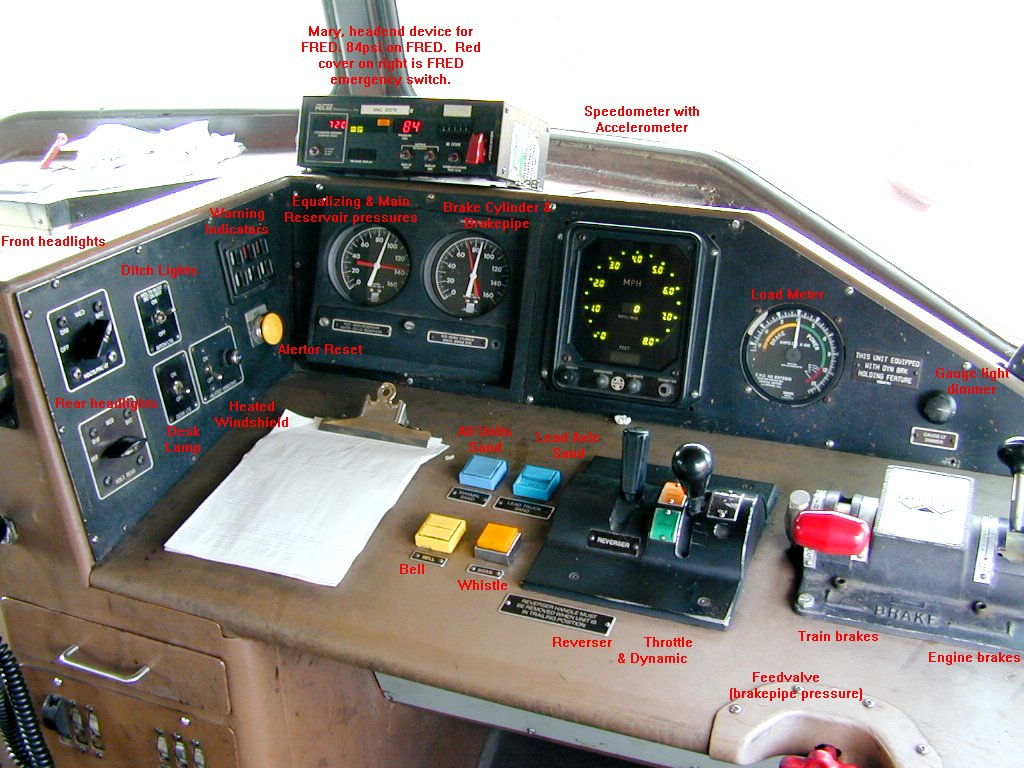
GP60M Cab Study On 3-17-00 I was on a P-SSEMEM (intermodal South Seattle to Memphis) that had 66 loads, 8 empties, 5631 tons, and was 6958 feet long. The power was BNSF 157, EMDX 9040, and BN 9693. These units are a GP60M (Warbonnet lettered BNSF), an Oakway (OWY) SD60, and a BN SD70MAC.
Long term readers of my posts are aware of the fact that I am not fond of any 4 axle power and the GP60Ms certainly reinforce that belief.
- Rough riding son of a guns. They are best at high speeds under full load which is what they are designed for. Unfortunately a heck of a lot of railroading is done well outside those parameters.
- The GP60M is a slippery beast at the often encountered combination of low speed/full throttle because of its high HP per axle.
- Aside from my usual disdain for 4 axle power I revile these units because of their cab design. Most of which to EMD's credit is not their fault but is ATSF/BNSF's.
- They have had alertors added to them after the merger. They used Quantum alertors instead of Pulse alertors. I dislike Quantum's because it goes off every 45 seconds regardless of speed. Pulse's alertors are keyed to the locomotive speed and vary the time delay between alerts. Unlike Quantum's, the Pulse model will go 3 minutes without alerting you at low speeds and alert in much shorter time intervals at high speeds. So these GP60Ms have two strikes against them right off, they are 4 axle and they have Quantum's.
- Incredibly the alertor reset button was placed far out of reach of the engineer! It is stuck in the farthest corner possible from the engineer's position. To reach it I must lean far to my left and stretch my arm and back out as far I can reach.
- To further complicate this matter the alertor does not reset automatically when you ring the bell as most other units do. It did however reset normally when I blew the whistle or changed the throttle or the DB setting. So the procedure became to toot the whistle every time the alertor went off. This of course turns on the bell. Rather than turn off the bell everytime I reset the alertor by honking the horn I just left it ding all night and day.
- The engineer's seat is mounted too far to the right. It is right up against the side wall which limits its swivel movement. It also places me too far to the side of the throttle/DB controller and air brake handles, offsetting them rather than being directly in front of me.
- The airbrake gauges are too far to the left. Combined with the far right seat position this gives a great deal of parallax when viewing the needles. EMD apparently realized this because they mounted these gauges on a skewed panel to better align them with the engineer's line of sight, but it does not go far enough.
- The GP60Ms like many ATSF units are equipped with those greenish/yellow LED "dot" type speedometers. I hate those too. I have been on many units where these things are all but impossible to read. As they age they get dimmer and dimmer. Even when new they are very difficult to see when the sun shines on them. Since it was dark most of the trip and overcast during the morning I could at least read this one OK.
- The ATSF used Colt radio heads that had the radio and FRED's headend device built into one unit. These things are useless! The radio's have a range of 1/4th our other brands. To change channels requires pushing two or 3 separate buttons and holding one while it slowly counts up. To go from the MRL's CH 15 to the BNSF CH 66 takes forever. Do you have any idea how difficult it is to hold your finger on a membrane type keypad at the far range of your reach for an extended time while the 4 axle unit is bouncing and crabbing along under you? It usually requires 3 or 4 tries. Often they are buggy. This one on the 157 was no exception. While trying to get from CH 19 (MRL yard) to CH 15 (MRL road) for a track warrant the darn thing would count down 19, 18, 17, 16, 13, 12! Son of a bitch. I'd push the "Change Channel" button again and then the count up button again. It would go 13, 14, 17, 18. I was getting pissed off. All this in the semi darkness of the weak cab light because the radio itself has no keypad lights. The legends are in very pale blue and very tiny font making the task all the more difficult. Of course I am supposed to be running the train during all this. Finally I got it to CH 15. I have to switch channels 5 times on my run and these things are the devils invention believe me.
- The BNSF does not use these for the FRED recievers anymore. So this unit had a standard Pulse Mary mounted up on top of the desk. It was far off to my left forcing me to stretch even farther than the alertor reset whenever I wanted to start or stop the footage counter. Being so far off center also gave the same parallax problem the airbrake gauges had. However, due to the GP60M's desk top design, mounting it anywhere else was out of the question.
- All of the EMD single source cab heaters are useless on low. They blow cold air. It was in the upper 30s to lower 40s all the way but this heater would freeze us on low and overheat us on medium. All these single source type EMD heaters do that. Older units had 4 independent cab heaters. Two blower heaters and two sidewall strip heaters. In that type of weather the sidwall heaters alone are usually sufficient. But EMD and ATSF/BN/BNSF in their wisdom left the electric sidewall heaters off all their EMD widenose units. GE's C44s have both.
- The heater control switch is ridiculous. It is mounted down by the engineer's left foot. The switch has 7 positions for heat, A/C, and blower. It is labeled with a tiny type font. I mean TINY! I held the computer printed track bulletins next to it and the switch font was about 2/3rds that of the printed sheet even though there was enough room to make it 4 times bigger than the track bulletin's. Come on EMD. Don't you people have any engineering sense at all. There is no light down there. I have to get down on my knees to get close to it. Just to adjust the darn cab heater. You people don't give a damn about your customers do you and apparentlyyour design engineers never sit in their creations.
I could probably go on about these GP60M cabs but by now you get the picture. Speaking of getting the the picture.....here it is...

I didn't realize it until just now but you can see in that photo one of the main reasons why I don't like desktop type controls. If you look at the bottom of the picture you can see the panel under the desk that severely limits knee room.
And here is a shot of the engineer's view out the window.
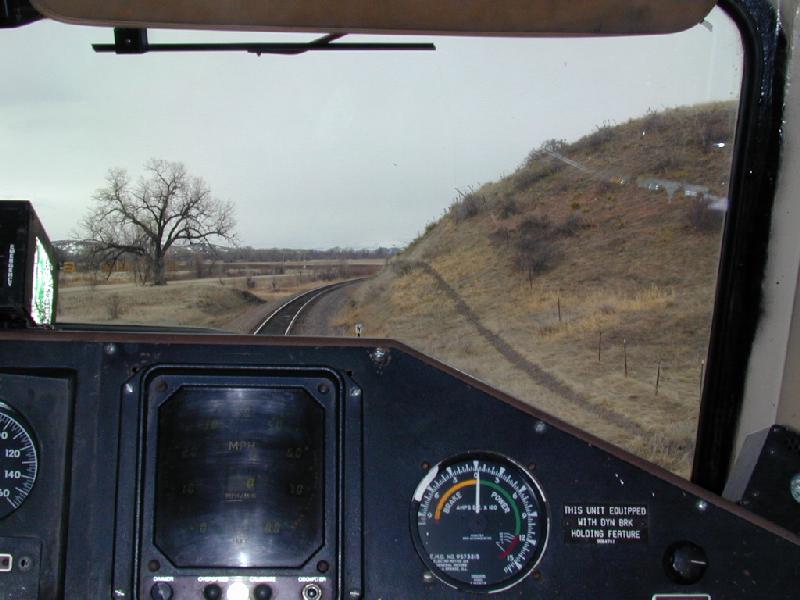
Seven of the 8 empties on this train were Boeing jetliner cars. One of the 7 cars had a high-wide restriction. It required us to stop and then walk it through a steel girder bridge just east of Lodge Grass, Montana. They put these cars, loaded or empties, first behind the power so they are up front to reduce the delay incurred doing this. Of course the one restricted car was the last of the 7. The cars with the "frames" on them are the ones used to haul the Boeing 737 fuselages on the westbound trips.
Here is a shot out of the cab window looking back at the train. We had stopped at the bridge, the conductor had gotten off, then I pulled the train ahead slowly to bring the 7th car up to the bridge where the conductor had dutifully watched it pass through the bridge unharmed as it has the other 2000 times it passed this way. I then stopped the train again and the conductor walked back to the locos and reboarded. I was just ready to pull when I snapped this photo.
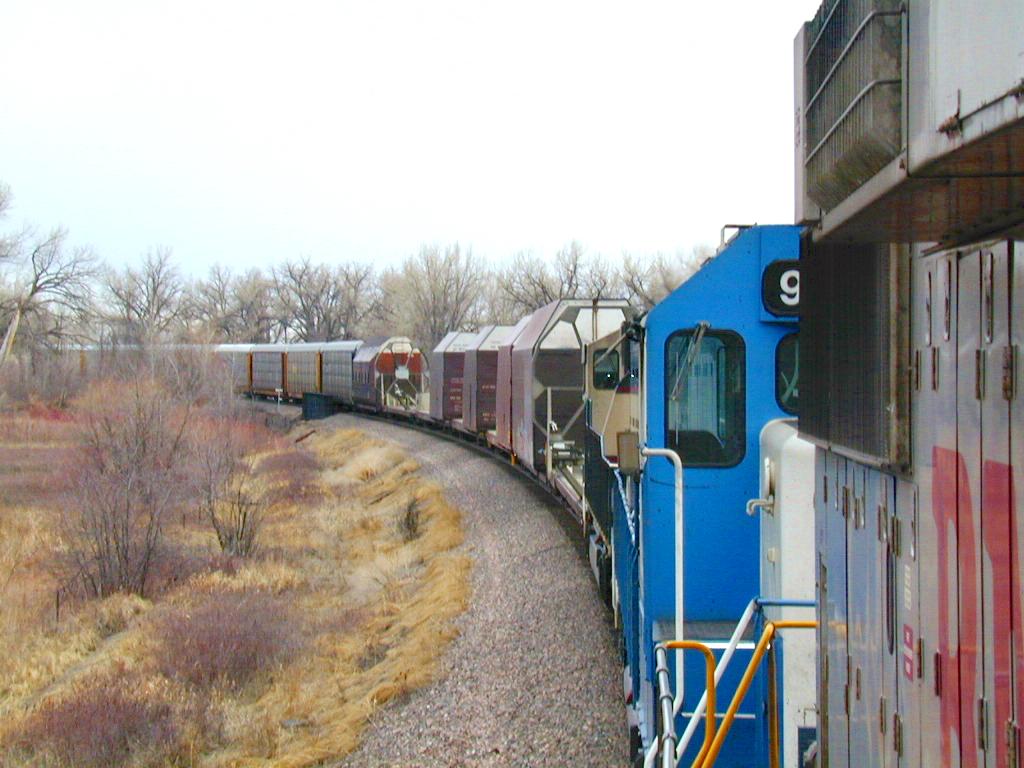
A minute later I have the entire train moving once againto continue the trip home. This picture is of the GP60M's ammeter as we accelerate the train.
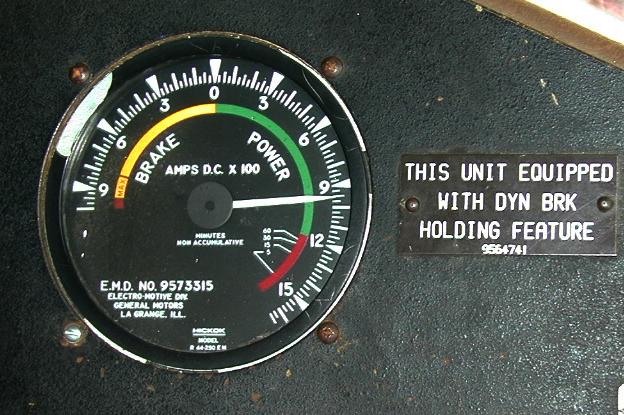
Now that you have looked at that unit I want to share withyou this photo of the same unit taken Feb 9, 1996 at Cajon by Bill Miller. Notice that the cab photo above was taken by me 4 years later when I had this unit as the leader on my train. It is still lettered Santa Fe in Bill's picture but it was lettered BNSF when I got it. It is amazing what they rebuild isn't it. Looking at ATSF 157 in February of 96, who'd have thought it?GP60M ATSF 157 wrecked at Cajon 2/96. Thanks to Bill Miller for the pic.
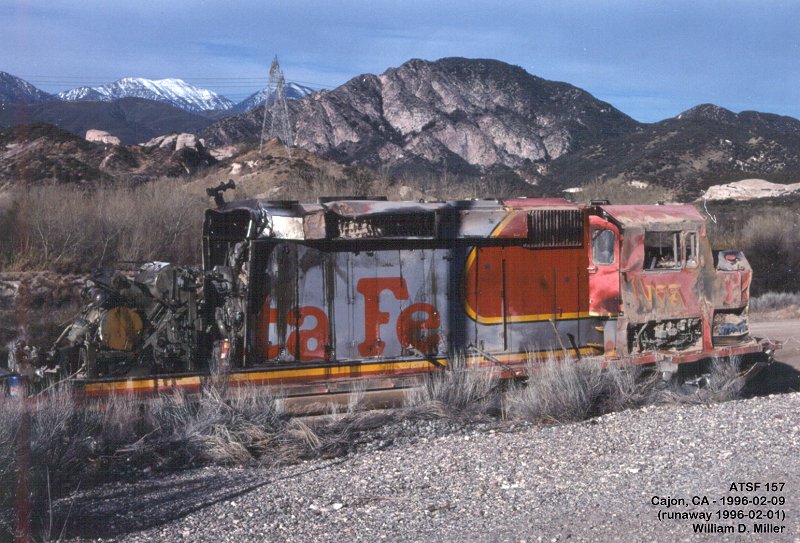



| Return to Tales index | My Home Page | E-Mail me |
Created 03-21-2000
Updated 04-20-2002